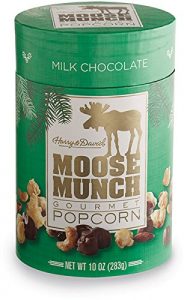Hunger Pang Lawsuit: Moose Munch Lacking a Bunch?
February 14th, 2017. By LucyC
 How much air is too much air? Who knows. BUT—we may be about to find out. No, not talking about this blog. Harry & David LLC gourmet foods got slapped with a consumer fraud class action lawsuit over slack fill in their popcorn canisters. There is some small irony here. What is popcorn if not flavored air? Surely that’s why it’s the diet food of choice for so many.
How much air is too much air? Who knows. BUT—we may be about to find out. No, not talking about this blog. Harry & David LLC gourmet foods got slapped with a consumer fraud class action lawsuit over slack fill in their popcorn canisters. There is some small irony here. What is popcorn if not flavored air? Surely that’s why it’s the diet food of choice for so many.
Back to the lawsuit. Filed by New Yorker Bria Brown, the lawsuit claims that an excessive amount of the 10 ounce package of (take a breath) Harry & David Moose Munch Milk Chocolate-flavored Gourmet Popcorn (got all that?) contained empty space—not including the popcorn.
Brown claims that she didn’t receive $7.99 worth of popcorn—expecting—reasonably, I would suggest—that the box would be almost full, if not completely full. Hey, if you’re on a diet, every ounce counts… Not saying Brown was on a diet. But if you’ve just shelled out eight bucks for some flavored popcorn—and you’re hungry—I doubt you’re going to be too pleased to find out you’ve got less food than you expected. Although I’m not sure popcorn is actually considered food.
I digress.
The lawsuit alleges Harry & David LLC is in violation of the Federal Food, Drug and Cosmetic Act, because that empty space in the box is “non-functional slack-fill” that tricks consumers into believing they are getting a full box of popcorn—for which they have paid. Precisely.
Brown’s sad story is that she bought her box of popcorn, with the world’s longest name, at a Macy’s retail store location in New York based on the reasonable assumption that the non-transparent cylindrical cardboard box was filled to functional capacity. However, upon opening the package, Brown said she learned that Harry & David’s products are packaged in transparent plastic pouches inside a non-transparent, cylindrical cardboard box “so that plaintiff and class members cannot see the non-functional slack-fill in the container.”
According to Brown, when she opened the box she discovered it was more than half empty, thereby causing her injury by depriving her of the benefit of her purchase, according to the complaint.
“Plaintiff and class members viewed defendant’s misleading products packaging, and reasonably relied in substantial part on its implicit representations of quantity and volume when purchasing the products,” the lawsuit states. “Plaintiff and class members were thereby deceived into deciding to purchase the products, whose packaging misrepresented the quantity of popcorn contained therein.” And not a little pissed off, as well, I’m betting.
“While some of defendant’s slack-fill may have functional justifications related to packaging requirements, defendant’s total slack-fill exceeds the amount necessary for this,” according to the complaint. “This is proven by the fact that the slack-fill in defendant’s products is significantly greater than the slack-fill in the packaging of comparable gourmet popcorn products.” Ah! A benchmark, of sorts. That’s always handy.
But it still begs the question—how much air is too much air?
FYI—the case is Bria Brown v. Harry & David LLC, case number 1:17-cv-00999, in the U.S. District Court for the Southern District of New York.
Archive by Category
- Accidents (24)
- Airlines (9)
- Asbestos Mesothelioma (262)
- Automotive (25)
- Celebrity (14)
- Class Action (84)
- Complaints/Comments (15)
- Consumer Fraud (84)
- Contest (2)
- Court of Public Opinion (5)
- Crazy Sh*t Lawyers See (61)
- Criminal Law (4)
- Defective Products (111)
- DePuy ASR Hip Recall (2)
- Discrimination (22)
- Drugs/Medical (248)
- Elder Care Abuse (4)
- Emerging Issues (462)
- Employment (54)
- Environment (52)
- Financial (28)
- Food Illness (15)
- Human/Civil Rights (4)
- Insecurities (5)
- Insurance (16)
- Intellectual Property (16)
- Internet/E-commerce (19)
- lawsuits (161)
- Lawyers (20)
- Lawyers Giving Back (43)
- Lex Levity (10)
- Personal Injury (106)
- Pleading Ignorance (53)
- Real Estate (2)
- Recall (6)
- Scam (3)
- Securities (13)
- Settlement (81)
- Tort Reform (2)
- Totally Tortelicious (81)
- Veterans (11)
- Whistleblower (9)
Interested in the results of the case